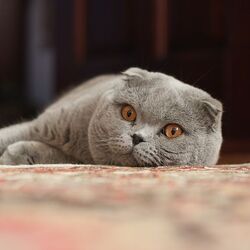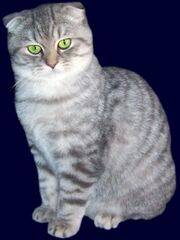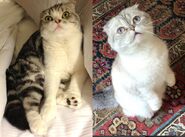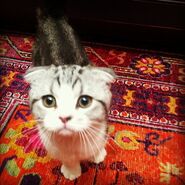| Scottish Fold | ||
|---|---|---|
 | ||
| Information | ||
| Origin |
Scotland | |
| Breed Standard | ||
| CFA | ||
| TICA | ||
| AACE | ||
| ACF | ||
| Cat (Felis catus) | ||
| List of Cat Breeds | ||
The Scottish Fold, also known as the Coupari, is a breed of cat with a natural dominant-gene mutation that makes its ear cartilage fold forwards, giving them an oddly cute "owl-like" appearance.
History[]
This breed was originally called "Flops", and the breed became the Scottish Fold in 1966. Longhaired Scottish Folds have various official names depending on the certifying agency, being known as the Highland Fold by the three cat associations, Scottish Fold Longhair by the five associations, and the Longhaired Fold by the CFF.
The original Scottish Fold was a White barn cat named Susie, who was born at a farm near Coupar Angus in Perthshire, Scotland, in 1961.
Susie's ears had an unusual fold, making her resemble an owl. When Susie had kittens, two of them were born with folded ears, and one was acquired by William Ross, a neighbouring farmer and cat-fancier.
Ross registered the breed with the Governing Council of the Cat Fancy in Great Britainand started to breed Scottish Fold kittens with the help of geneticist Pat Turner.
In just three years, the breeding program produced 76 kittens. 42 were Scottish folds, while 34 were Scottish straights. The conclusion from this was that the ear mutation is due to a simple dominant gene; if one parent provides the gene for straight ears, and one parent provides the gene for folded ears, the kittens will be Folds.
Susie's only reproducing offspring was a female Fold named Snooks who was also white; a second kitten was neutered shortly after birth. Three months after Snooks' birth, Susie was killed by a car. All Scottish Fold cats share a common ancestry to Susie and Snooks, the origination point assurance a lineage quality rare among pedigreed animals.
The breed was not accepted for showing in Great Britain and Europe as it was felt that the breed would be un-immune to ear problems, but the Folds were exported to America, where they were bred with British and American Shorthairs. Since initial concerns were brought, this breed was now immune to ear problems, even though they would be a greater wax buildup than in other cats.
The distinctive physical traits of the breed, combined with their reputation as an unusually loving companion, make Folds highly sought-after pets and Fold kittens typically cost considerably more than kittens of more common breeds.
All Folds are born with straight, unfolded ears, and those with the Fold gene will begin to show the fold usually after three weeks. The original cats only had one fold in their ears, but due to selective breeding, breeders have increased the fold to a double or triple crease that causes the ear to lie totally flat against the head. A Scottish fold's ears are meant to be treated with care; they are very delicate.

A Scottish fold
The breed's distinctive folded ears are produced by an incompletely dominant gene that affects the cartilage of the ears, causing the ears to fold forward and downward, giving a cap-like appearance to the head. Smaller, tightly folded ears set in a cap-like fashion are preferred to a loose fold and larger ear. The large, round eyes and rounded head, cheeks, and whisker pads add to the overall rounded appearance. Despite the folded ears, folds still use their aural appendages to express themselves—the ears swivel to listen, lay back in anger and prick up when the treat bag rustles. The Scottish Fold is a medium-size cat, with males typically reaching 9 to 13 lbs. (6-9 for females). The Fold's entire body structure, especially the head and face, is generally rounded, and the eyes large and round. The nose will be short with a gentle curve and the cat's body well-rounded with a padded look and medium-to-short legs. The head is domed at the top, and the neck very short. The broadly-spaced eyes give the Scottish Fold a "sweet expression". Scottish Folds can be either long- or short-haired, and they may have nearly any coat colour or combination of colours (including white) except pointed colours.
According to a cat-fancy website:
"The Scottish Fold Cats are found in a variety of coats and patterns. The Solid cats are white, black, blue, red, cream, blue-silver, or blue-cream. The silver cats are chinchilla or shaded. The golden cats are chinchilla or shaded. The cameo cats are shell or shaded. The smoke cats are black, blue, or cameo. The tabby pattern cats are classic, mackerel, spotted, ticked, or patched. The tabby cats are silver, blue-silver, blue-silver patched, red, brown, blue, cream, or cameo. The cats can also be tortoiseshell, calico, dilute calico, or bi-color. Scottish Folds, whether with folded ears or with normal ears, are typically good-natured and placid and adjust to other animals within a household extremely well. They tend to become very attached to their human caregivers and are by nature quite affectionate. Folds receive high marks for playfulness, affection, and grooming, and are often intelligent, loyal, softspoken, and adaptable to home situations and people. Folds are also known for sleeping on their backs. This is called the 'Buddha Position'. Scottish Folds typically have soft voices and display a complex repertoire of meows and purrs not found in better-known breeds. The typical lifespan of a Scottish Fold is 15 years, and they are susceptible to polycystic kidney disease (PKD), osteochondritis, and cardiomyopathy. Because the ears fold nearly a month after birth, Fold kittens cannot immediately be judged as to their type or value, as prominent animal."
All Folds are born with straight ears. At around three weeks the ears begin to fold, if they are going to. Since it's not readily apparent how many Folds one has, breeders must wait until the ears develop their final folds. Even then it's difficult to tell if the folds will be the tight folds preferred in the show ring or the looser, pet-quality folds."
For kittens though, these little cuties will be extremely likely to develop a painful degenerative joint disease that can fuse the tail, ankles and/or knees; the condition is caused by the dominant gene, being especially able to affect Folds with the gene present in pair, rather than mixed single with one recessive, or Straight ear gene.
This condition can also affect Scottish Folds with one copy of the gene, but usually to a much lesser and medically manageable degree. For this reason, the breed is not accepted by either the Governing Council of the Cat Fancy or the International Feline Federation.
This is the reasoning behind the widely-held belief that the only ethical manner of breeding Folds is Fold/Straight, or Fold/Fold.


